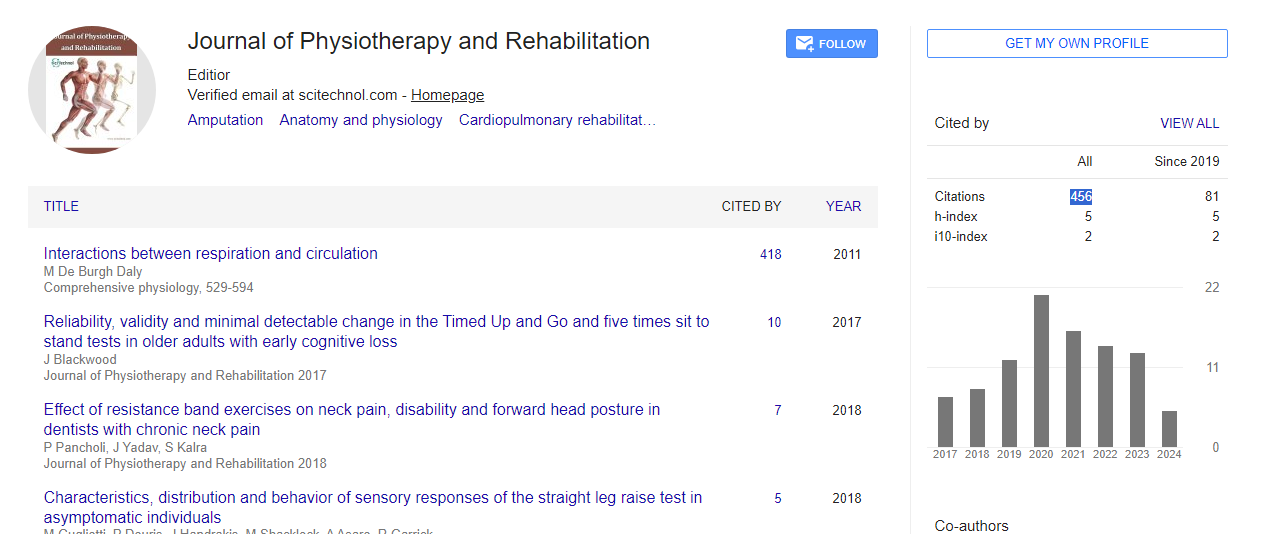Short Communication, J Physiother Rehabi Vol: 8 Issue: 5
Secondary Damage Mechanisms and Interventions in Acute Spinal Cord Injury Treatment
Grace Kim*
1Department of Rehabilitation, UT Health McGovern Medical School, TIRR Memorial Hermann, USA
*Corresponding Author: Grace Kim,
Department of Rehabilitation, UT Health
McGovern Medical School, TIRR Memorial Hermann, USA
E-mail: grace.kim123@rehabn.com
Received date: 24 September, 2024, Manuscript No. JPTR-24-151647
Editor assigned date: 26 September, 2024, PreQC No. JPTR-24-151647 (PQ);
Reviewed date: 10 October, 2024, QC No. JPTR-24-151647
Revised date: 17 October, 2024, Manuscript No. JPTR-24-151647 (R);
Published date: 24 October, 2024, DOI: 10.4172/JPTR.1000191.
Citation: Kim G (2024) Secondary Damage Mechanisms and Interventions in Acute Spinal Cord Injury Treatment. J Physiother Rehabi 8:5.
Description
Acute Spinal Cord Injury (SCI) is a injurious condition that leads to permanent neurological deficits and significant physical disability. While the initial trauma to the spinal cord results in primary damage, a complex series of secondary injury mechanisms amplify the extent of tissue damage and functional loss [1]. These secondary mechanisms, which occur in the hours to days following the injury, are critical to understand as they offer a window of opportunity for therapeutic interventions aimed at minimizing further damage and improving outcomes. Secondary damage in SCI involves a rapids of biochemical, cellular and molecular events. These include ischemia, inflammation, excitotoxicity, oxidative stress and apoptosis, all of which contribute to the progressive degeneration of neural tissue [2]. Ischemia or the lack of sufficient blood flow to the injured area is one of the earliest events following SCI. The initial mechanical injury damages blood vessels within the spinal cord, leading to impaired perfusion, oxygen deprivation and energy failure in the affected area. This lack of oxygen and nutrients triggers a series of cellular responses that further compromise the survival of neurons and glial cells [3,4].
Inflammation is another type of secondary injury. Within hours after the trauma, inflammatory cells such as neutrophils, macrophages and microglia are recruited to the site of injury. While inflammation plays a role in clearing cellular debris, it can also become detrimental by promoting further damage [5]. The release of pro-inflammatory cytokines and chemokines amplifies the inflammatory response, leading to the breakdown of the blood-spinal cord barrier, swelling and further ischemia. Additionally, activated immune cells release Reactive Oxygen Species (ROS) and nitric oxide, contributing to oxidative stress and further neuronal injury. Excitotoxicity is a process by which excessive release of excitatory neurotransmitters, particularly glutamate, leads to neuronal death. Following SCI, damaged neurons release large amounts of glutamate, which overstimulates receptors on neighboring neurons [6]. This overstimulation allows a massive influx of calcium ions into the cells, triggering enzymatic pathways that lead to cell death through mechanisms such as mitochondrial dysfunction and the activation of proteases [7]. Excitotoxicity not only causes immediate damage to neurons but also disrupts synaptic function, impairing communication between surviving neurons [8].
Oxidative stress, driven by the overproduction of ROS and other free radicals, further compounds the damage in SCI. Normally, cells have antioxidant defense systems that neutralize these harmful molecules. However, after spinal cord injury, the balance between ROS production and antioxidant defenses is disrupted, leading to the accumulation of oxidative damage to lipids, proteins and DNA. This oxidative damage contributes to the degeneration of both neurons and the supporting glial cells, such as oligodendrocytes, which are responsible for maintaining the myelin sheath around axons [9]. Apoptosis or programmed cell death is another major component of secondary damage. While necrosis, a form of uncontrolled cell death, occurs primarily in the immediate aftermath of the injury, apoptosis continues to cause cell loss over a prolonged period. Neurons, oligodendrocytes and astrocytes all undergo apoptosis in the days and weeks following SCI. This cell death contributes to the formation of cystic cavities and glial scars within the spinal cord, further hindering the potential for regeneration and recovery of function [10].
Conclusion
Understanding the mechanisms of secondary damage in acute spinal cord injury is crucial for developing effective treatments. While primary injury is unavoidable, interventions that target secondary damage can potentially limit the progression of injury and improve long-term outcomes for individuals with SCI. The ongoing research into neuroprotective, anti-inflammatory and regenerative therapies offers hope for future advancements in the management of this debilitating condition.
References
- Baptiste DC, Fehlings MG (2007) Update on the treatment of spinal cord injury. Prog Brain Res 161:217-233.
[Crossref] [Google Scholar] [PubMed]
- McDonald JW, Sadowsky C (2002) Spinal-cord injury. Lancet 359(9304):417-425.
[Crossref] [Google Scholar] [PubMed]
- Cadotte DW, Fehlings MG (2011) Spinal cord injury: A systematic review of current treatment options. Clin Orthop Relat Res 469(3):732-741.
[Crossref] [Google Scholar] [PubMed]
- Hulsebosch CE (2002) Recent advances in pathophysiology and treatment of spinal cord injury. Clin Orthop Relat Res 26(4):238-255.
[Crossref] [Google Scholar] [PubMed]
- Venkatesh K, Ghosh SK, Mullick M, Manivasagam G, Sen D (2019) Spinal cord injury: Pathophysiology, treatment strategies, associated challenges and future implications. Cell Tissue Res 377 (2):125-151.
[Crossref] [Google Scholar] [PubMed]
- Nas K, Yazmalar L, Şah V, Aydın A, Öneş K (2015) Rehabilitation of spinal cord injuries. World J Orthop 6(1):8.
[Crossref] [Google Scholar] [PubMed]
- Hachem LD, Ahuja CS, Fehlings MG (2017) Assessment and management of acute spinal cord injury: From point of injury to rehabilitation. J Spinal Cord Med 40(6):665-675.
[Crossref] [Google Scholar] [PubMed]
- Burns AS, Marino RJ, Kalsi-Ryan S, Middleton JW, Tetreault LA, et al. (2017) Type and timing of rehabilitation following acute and subacute spinal cord injury: A systematic review. Global Spine J 7(3_suppl):175-194.
[Crossref] [Google Scholar] [PubMed]
- Burns AS, Ditunno JF (2001) Establishing prognosis and maximizing functional outcomes after spinal cord injury: A review of current and future directions in rehabilitation management. Spine 26(24S):137-145.
[Google Scholar] [PubMed]
- Sumida M, Fujimoto M, Tokuhiro A, Tominaga T, Magara A, et al. (2001) Early rehabilitation effect for traumatic spinal cord injury. Arch Phys Med Rehabil 82(3):391-405.
[Crossref] [Google Scholar] [PubMed]
 Spanish
Spanish  Chinese
Chinese  Russian
Russian  German
German  French
French  Japanese
Japanese  Portuguese
Portuguese  Hindi
Hindi 